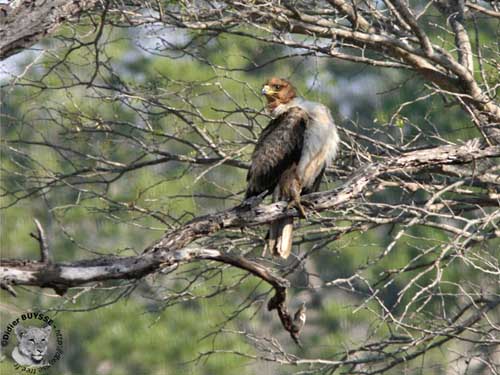
Text by Nicole Bouglouan
Photographers :
Didier Buysse
Vision d’Oiseaux
Patrick Ingremeau
TAMANDUA
Ingo Waschkies
Bird Photography
Callie de Wet
Flickr Galleries
Nicole Bouglouan
PHOTOGRAPHIC RAMBLE
Sources :
HANDBOOK OF THE BIRDS OF THE WORLD Vol 2 by Josep del Hoyo-Andrew Elliot-Jordi Sargatal - Lynx Edicions - ISBN: 8487334156
BIRDS OF PREY OF AFRICA AND ITS ISLANDS by Alan and Meg Kemp - Struik Publishers - ISBN: 1770073698
GUIDE DES RAPACES DIURNES – Europe, Afrique du Nord et Moyen-Orient de Benny Génsbol – Delachaux et Niestlé – ISBN : 2603013270
LES AIGLES par Maurice Dupérat - Artémis Editions - ISBN: 2844164536
Article Booted Eagles - Introduction
Booted eagles
Genus Hieraaetus
The genus Hieraaetus includes smaller eagles than Ictinaetus and Aquila. They have usually paler plumage, from brown, pale brown to buff on the upperparts, and paler underparts from white to pale buff, with markings or not.
The Wahlberg’s Eagle (H. wahlbergi) has brown upperparts and paler underparts. But we can find three morphs, pale, dark and buff, and several variations.
The pale morph has contrasted plumage with dark brown upperparts and crest, and whitish head and underparts.
The dark morph has brown plumage overall, with paler edges to upperparts’ feathers.
The buff morph has buff plumage with dark brown to blackish flight feathers and tail.
On the head, we can see a short crest on the crown. The bill is black. The eyes are brown. Cere, legs and feet are yellow.
There is another form named “dark-headed morph” with buff body plumage and dark brown head.

H. wahlbergi
This species occurs in Africa, South of the Sahara. It breeds in E, C and S Africa and winters in NE of equator where there are some resident birds.
It frequents the savannahs with trees and the woodlands, but it avoids the desert and the dense forest. It is often seen near water.
The Wahlberg’s Eagle feeds primarily on reptiles, birds and small mammals (from rodents to hares), and some insects. As numerous raptors, it hunts from perch or by soaring flight and stoops down onto the prey. Attacks are rapid and the preys can be caught on the ground or after aerial pursuit.
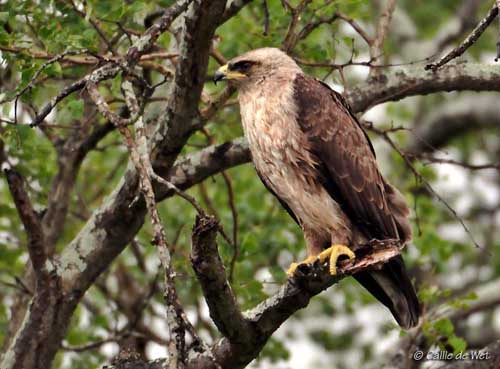
H. wahlbergi
This species breeds during the wet season. The stick nest is a small platform in fork in tall tree, often near water and at woodlands’ edge. The same nest-site may be reused year after year.
The female lays a single egg, rarely two, and incubates during 44-46 days. The chick fledges 70-75 days after hatching.
The Wahlberg’s Eagle is a common species in S and C Africa, but less common in W Africa. The species is vulnerable to degradation of woodland and some local declines are reported.
The Bonelli’s Eagle (H. fasciatus) is slightly larger with a length of about 70 cm and a wingspan of 180 cm. It has contrasted plumage with dark brown upperparts and head. We can see a whitish patch in the middle of the back. The underparts are whitish and finely streaked black. The tail shows broad terminal dark band.
The female is larger and more heavily streaked below. The juvenile is brownish with dark brown upperparts and rusty underparts.
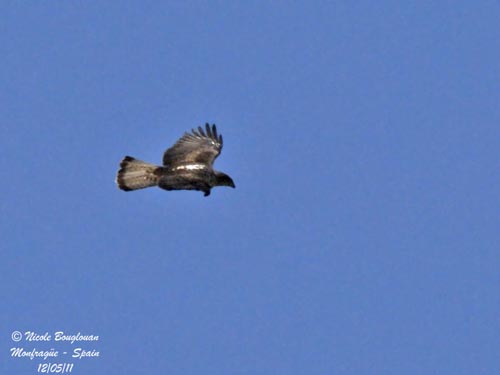
This species occurs around the Mediterranean Basin, in N Africa, S Europe, Middle-East, India and S China.
This eagle is sedentary in its range, only performing some dispersion. The young birds move once independent, leaving the nesting areas to move to cultivated fields where they can find numerous preys.
The adults frequent mountainous and broken areas with crags and cliffs, and open areas with shrubs and bushes. It is usually seen at low or medium elevation, but it may occur up to 2000 metres in NW Africa and Asia.
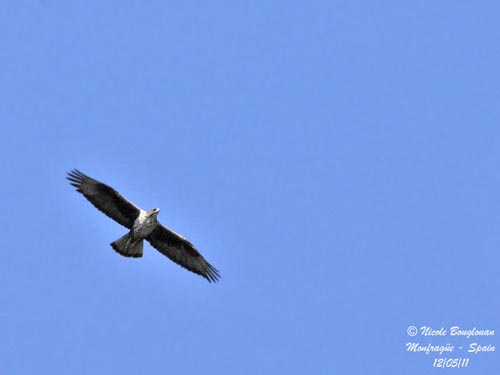
The Bonelli’s Eagle feeds usually on medium-sized birds and mammals such as partridges and rabbits, but other animals are taken if these are scarce. It may catch larger preys such as storks, herons and foxes.
Preys are mainly caught on the ground, but its agile flight allows it to take birds in flight after fast pursuit. Pairs may hunt together sometimes.
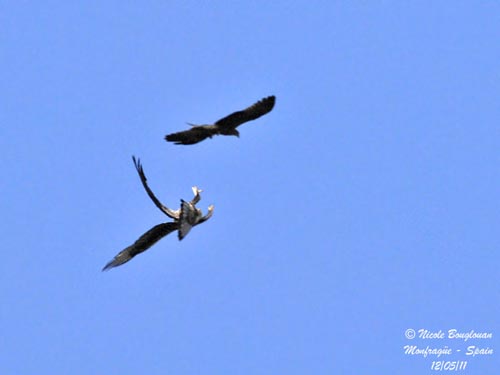
This eagle nests on cliff ledges, occasionally in tree according to the region. The bulky nest is made with sticks and lined with green leaves. There are several nests per pair, close to each other on the same cliff face and used alternatively.
The female lays 1-2 eggs and incubates during 37-41 days. She broods and feeds the chicks with the food brought at nest by the male. The young fledge 60-70 days after hatching, and remain within the territory during several months.
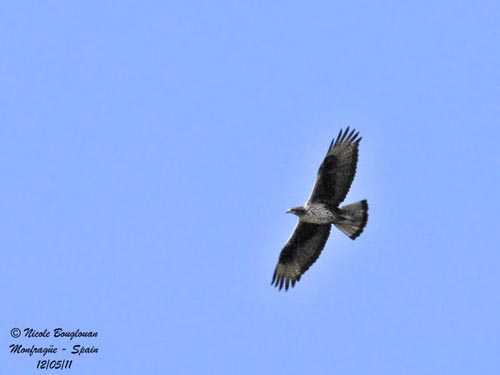
The Bonelli’s Eagle declined in Europe but there are local stable populations. Competitions occur with other eagles in Spain, such as the Golden Eagle and the Spanish Imperial Eagle in areas of high density of these species.
Declines could be the result of direct persecution, and also collisions with power lines. But the degradation of the habitat, the reduction of numbers of favorite preys and human disturbance are important threats for this species.
H. fasciatus
H. fasciatus
H. fasciatus
The Booted Eagle (H. pennatus) is the smallest European Eagle with a length of 50-55 cm and a wingspan of 120-130 cm. This eagle occurs in two morphs, pale and dark, with several variant and intermediate plumages.
The pale morph is more often seen. It has brown upperparts showing paler areas on wings, head and back. The underparts are whitish with variable reddish markings.
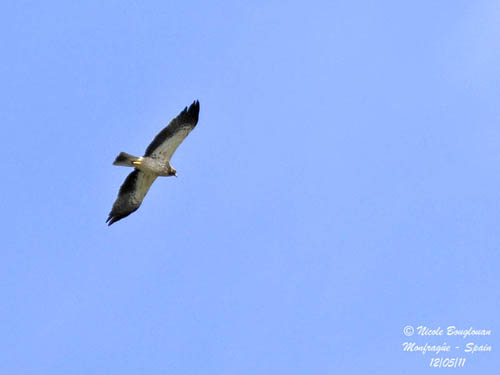
The dark morph has dark brown plumage overall and paler tail. We can see a white patch on shoulders, more conspicuous in flight.
Head and neck are pale rufous and more or less streaked. The bill is black with yellow cere. The eyes are dark brown. The feathered legs are whitish or brown according to the morph, and the feet are yellow.
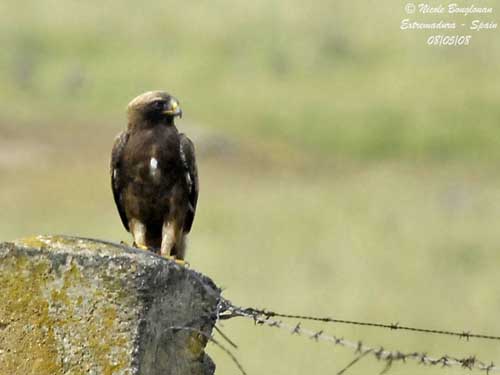
The Booted Eagle frequents deciduous or mixed forests with clearings, but also flat lands and mountain slopes. This species may occur at high elevation, up to 3000 metres in India, and between 2000 and 2700 metres according to the range.
This migratory eagle breeds in SW and W Europe to C Asia, and in narrow coastal area in N Africa. It winters in Africa, south of the Sahara and S Asia, mainly India.
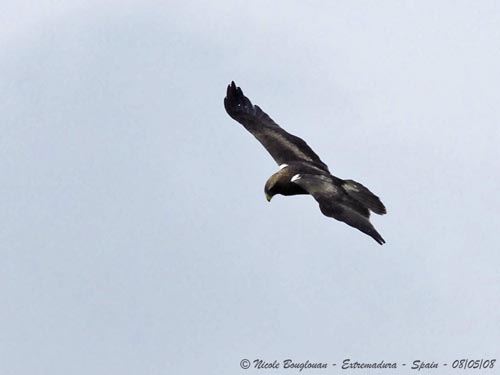
The Booted Eagle is a powerful raptor in spite of its small size. It feeds mainly on small and medium-sized birds (from small passerines to pigeons), mammals (from rodents to rabbits), reptiles and lizards and large insects.
Very agile in flight, it is able to fly between trees to surprise the preys. It also hunts from perch or by soaring flight, and performs sometimes hovering. It stoops down onto the prey on the ground. The pairs may sometimes hunt together.
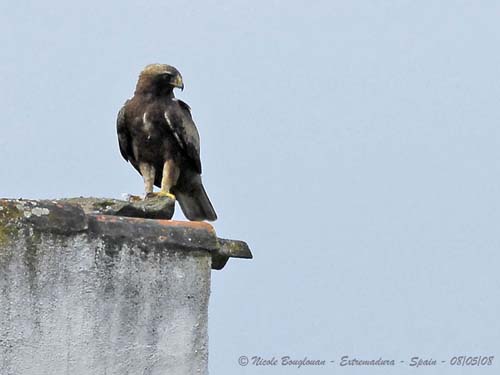
The flight displays occur above the forest. The birds circle while descending abruptly to the treetops. Then, they rise again above open areas. They often call during these displays.
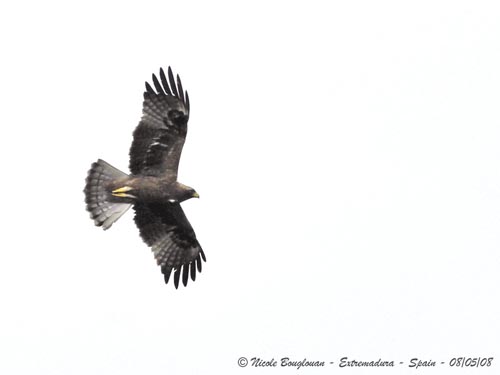
The large stick nest is usually placed in tree, but also occasionally on ledges or small trees on cliff faces.
The female lays two eggs and incubates during 37-40 days, while the male feeds her at nest. The chicks are fed by both adults, and fledge 50-54 days after hatching. The young remain with their parents for two months more.
The Booted Eagle, as numerous species, is threatened by degradation of the habitat, human persecutions and decline of the preys.
However, the species is not currently threatened, but the population numbers are not well known.
The Little Eagle (H. morphnoides) occurs in New Guinea and Australia. This small eagle (50-55 cm) shows two morphs, pale and dark.
In pale morph, the underwing pattern is characterisitic, with contrasted white greater coverts.
In dark morph, underparts and underwing are brown, but may vary from creamy-white to pale chestnut. Cere and feet are pale.
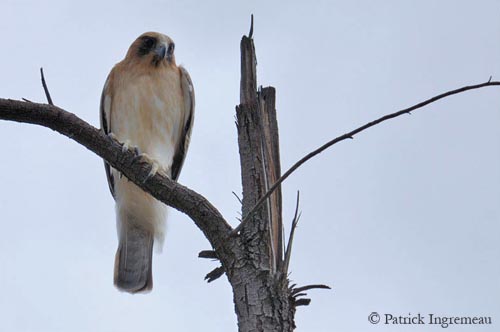
This eagle frequents open forest, scrubs and savannahs, and can be seen from sea-level up to 1500 metres of elevation in Australia, and up to almost 2000 metres in New Guinea. It usually avoids the treeless areas, but also the dense forests, althought it occurs in rainforest in New Guinea.
The Little Eagle feeds on mammals (up to 1500 grams), birds (parrots and passerines), reptiles (rarely snakes), and sometimes large insects and carrion.
It hunts by high soaring fligth, but also by low flight between perches, or directly from perch. The prey is caught on the ground, after glide or dive, or rapid stoop to the canopy. Preys are rarely caught on the wing.
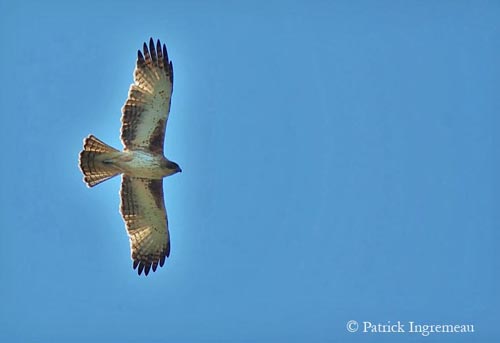
This eagle nests in forest and woodland, and often in riparian habitat in arid areas. It is solitary nester, but may sometimes breed near other raptors' species. The stick nest is a platform lined with green leaves, placed in treefork.
The female usually lays two eggs and incubates during about 36-41 days. The chicks are fed by both parents, and fledge between 54 and 66 days after hatching. They depend on parents for two months more.
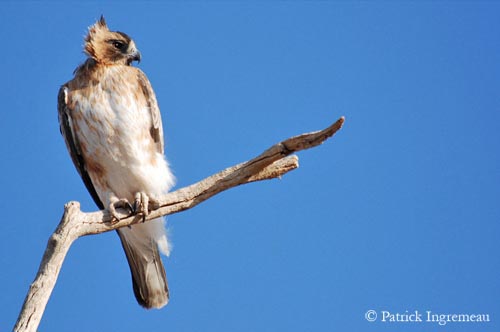
The Little Eagle breeding adults are sedentary in the range, whereas some birds, usually females, performs altitudinal movements and spend the winter in coastal and lower areas. The juveniles are dispersive.
This species is common and relatively widespread in Australia, taking advantage of introduction of rabbits. It could be vulnerable to habitat clearance and loss of trees. But the species is not currently threatened.
Hieraaetus morphnoides
Hieraaetus morphnoides
Hieraaetus morphnoides
Some other eagles have changed of genus according to the different classifications.
The Ayres's Hawk-eagle and the African Hawk-eagle belong now to the genus Aquila, whereas the Wahlberg's Eagle is included here in Hieraaetus. It was formerly included in Aquila.
But they are all very similar, as well in appearance as in behaviour. Changes of genus are mainly caused by DNA analysis. But all are eagles and they live as the other raptors!
The Rufous-bellied Eagle (Hieraaetus kienerii) is found in SE Asia (race “Formosus”) and in NE India, Nepal, SW India and Sri Lanka (race “kienerii”).
This small eagle of 90-130 cm of wingspan is a very good flier. It has dark plumage on upperparts and head, where we can see a short bushy crest. On the underparts, chin, throat and breast are white finely streaked black. Belly and underwing-coverts are bright rufous. The eyes are dark brown. Cere, legs and feet are yellow. The bill is black.
The juvenile has white underparts and underwing.
The race “Formosus” here displayed, is smaller with darker upperparts.
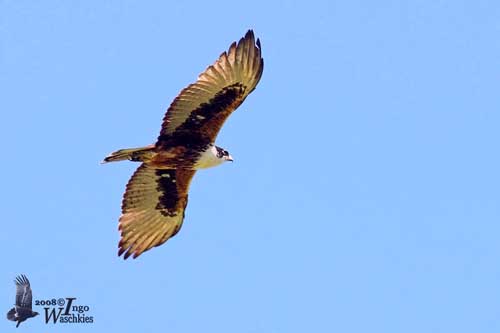
Rufous-bellied Eagle
Hieraaetus kienerii formosus
This species frequents humid evergreen forest from foothills up to 1500 metres or higher.
It is mainly an aerial hunter. It feeds on mammals (rodents) and birds (from pigeons to pheasants). The preys are caught on the ground or treetops, after impressive stoops, very similar to falcons.
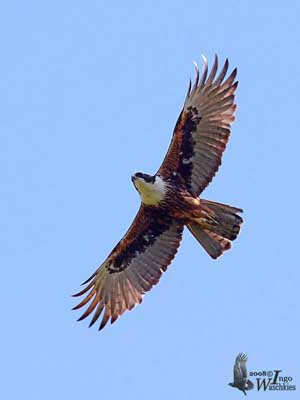
During the breeding season, the Rufous-bellied Eagle performs spectacular aerial displays, with shivering of wings and repeated dives with closed wings.
The pair builds the large stick nest in tall tree in dense forest, often in the crown. The interior is lined with greenery.
The nest is strongly defended by both adults, especially against humans.
Only one egg is laid, and both parents incubate.
This eagle is mainly sedentary in its range, with some migrations reported in Malay Peninsula.
The species is widespread according to the range, but the continuous deforestation is an important threat for this beautiful raptor.